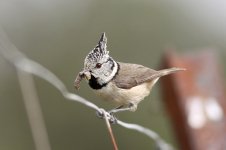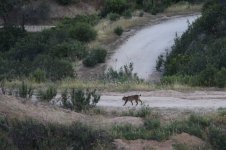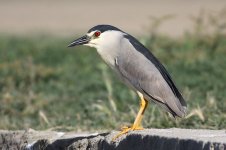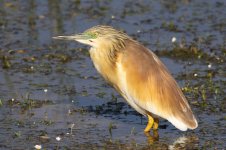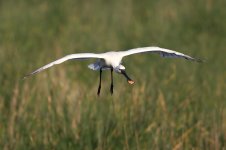
Swirling Icelandic dust clouds, Spanish airports closed, all was not looking good for my little foray into the land of El Lynx. From up above however, the Gods of the Feline must surely have been smiling down - one day prior to my departure, the skies miraculously cleared, Malaga reopened and it was all systems go, trip back on.
13 May. Departure Day.
So it was, after finishing work on the Thursday, a friend and I hopped onto a plane to the UK and, after a mere two-hour stop-over in the airport coffee bar, continued onward to the delights of Spain. Touchdown at 11 p.m. local time, picked up a hire car and began the trip north, destination Andujar, haunt of the cats.
An uneventful journey, no birds or mammals disturbing the drive (bar one Iberian Hare which I spectacularly managed to not see). Arrived at 2.30 a.m. to a distinctively chilly 8 C ….brrr, this was supposed to be southern Spain!
14 May. Andujar.
4.00 a.m., refreshed after an hour and a half kip in the car, it was time for the first trawl the local byways, mammal spotting the quest. Great looming bulks in the dark, Red Deer by the bucket load, plenty of Rabbits adding fodder, up the winding road I bumped, imagining the Lynx that must surely be lurking somewhere near. A blur of wings, then atop a pole sat a Tawny Owl, first bird of the trip.
Light now etching the horizons, a Red Fox picked its way through a meadow of Spanish bulls, mean-looking things, certainly not most inviting to any wayward trespass! Hints of dawn, Nightingales and Golden Orioles cranked the early morning chorus into gear, it was time to begin the long vigil for El Lynx.
Up at my chosen vantage point, the expansive rolling slopes lit by the first rays of the morning, I was immediately taken aback - a vast mosaic of arid scrub, rock and bush stretching kilometres and kilometres, this had every potential to be a very long search! I had no illusions to the contrary, I had pencilled in three or four days to sit upon this hillside, scanning and watching, the single one purpose of my trip to see Iberian Lynx. I parked the car, had a quick chat a Spanish guy already slumped in a chair for his day of wait, then wandered along the road to select my vantage point for the hours that would surely follow.
A half kilometre up the road, Common Swifts hurtling overhead, an early Griffon Vulture lumbering into the air, my ear caught the chacking of Magpies, some mighty peeved birds ahead. Hmm, thought I, well aware of a possible cause, but not truly believing it could be. Another Magpie flew over, swooping down the hillside to join the fracas. I perched upon a rock and watched the goings on, the Magpies were intend on something! Maybe a raptor, maybe not, I scanned to the right …Christ! I almost rolled off my rock!!! Right there, three or four hundred metres down, a fantastic Iberian Lynx strolled right out into the open, Magpies in tow. My eyes were like saucers, I was stunned, I had expected a wait of days and here I was, just 15 minutes into the search and I was looking at a most amazing animal.
Generosity in my heart, I remembered not only my companion still asleep in the car, but also the Spanish guy down the road. I have not run so fast for many a year - almost killing myself in the process, just a few minutes later the three of us were back on the hillside. Where was the Lynx? Chacking Magpies hinted a continued presence, I scanned to no avail. A full two minutes passed, then my now-awake companion spotted the Lynx on the move, followed by a sudden exclamation from the Spanish guy, the cat was back in view. Multilingual directions, but I could see nothing. Then I understood why - I was still scanning the area where I had initially found the Lynx, but it was now actually much closer! Having realised both the other two were watching the nearest slope, the cat was then easy to pick out, the views were fantastic, moving steadily towards us, closer and closer. A few moments later, I think the shouts were simultaneous ‘two’, ‘dos’, ‘another’ - suddenly our Lynx had transformed into two Lynx! We now had a pair of Lynx and, just to add the final icing to the cake, they then ambled onto a rock outcrop barely a hundred metres from us, climbing to the top, then pausing to lick paws and greet each other. Magic moment of the year!
Onward they continued, off the rocks, across the road and into the bushes above us, all too soon lost them to view. It was now 7.40 a.m., we warmly congratulated ourselves, we had just had 20 minutes of unbeatable views, not what I had expected on my first morning.
13 May. Departure Day.
So it was, after finishing work on the Thursday, a friend and I hopped onto a plane to the UK and, after a mere two-hour stop-over in the airport coffee bar, continued onward to the delights of Spain. Touchdown at 11 p.m. local time, picked up a hire car and began the trip north, destination Andujar, haunt of the cats.
An uneventful journey, no birds or mammals disturbing the drive (bar one Iberian Hare which I spectacularly managed to not see). Arrived at 2.30 a.m. to a distinctively chilly 8 C ….brrr, this was supposed to be southern Spain!
14 May. Andujar.
4.00 a.m., refreshed after an hour and a half kip in the car, it was time for the first trawl the local byways, mammal spotting the quest. Great looming bulks in the dark, Red Deer by the bucket load, plenty of Rabbits adding fodder, up the winding road I bumped, imagining the Lynx that must surely be lurking somewhere near. A blur of wings, then atop a pole sat a Tawny Owl, first bird of the trip.
Light now etching the horizons, a Red Fox picked its way through a meadow of Spanish bulls, mean-looking things, certainly not most inviting to any wayward trespass! Hints of dawn, Nightingales and Golden Orioles cranked the early morning chorus into gear, it was time to begin the long vigil for El Lynx.
Up at my chosen vantage point, the expansive rolling slopes lit by the first rays of the morning, I was immediately taken aback - a vast mosaic of arid scrub, rock and bush stretching kilometres and kilometres, this had every potential to be a very long search! I had no illusions to the contrary, I had pencilled in three or four days to sit upon this hillside, scanning and watching, the single one purpose of my trip to see Iberian Lynx. I parked the car, had a quick chat a Spanish guy already slumped in a chair for his day of wait, then wandered along the road to select my vantage point for the hours that would surely follow.
A half kilometre up the road, Common Swifts hurtling overhead, an early Griffon Vulture lumbering into the air, my ear caught the chacking of Magpies, some mighty peeved birds ahead. Hmm, thought I, well aware of a possible cause, but not truly believing it could be. Another Magpie flew over, swooping down the hillside to join the fracas. I perched upon a rock and watched the goings on, the Magpies were intend on something! Maybe a raptor, maybe not, I scanned to the right …Christ! I almost rolled off my rock!!! Right there, three or four hundred metres down, a fantastic Iberian Lynx strolled right out into the open, Magpies in tow. My eyes were like saucers, I was stunned, I had expected a wait of days and here I was, just 15 minutes into the search and I was looking at a most amazing animal.
Generosity in my heart, I remembered not only my companion still asleep in the car, but also the Spanish guy down the road. I have not run so fast for many a year - almost killing myself in the process, just a few minutes later the three of us were back on the hillside. Where was the Lynx? Chacking Magpies hinted a continued presence, I scanned to no avail. A full two minutes passed, then my now-awake companion spotted the Lynx on the move, followed by a sudden exclamation from the Spanish guy, the cat was back in view. Multilingual directions, but I could see nothing. Then I understood why - I was still scanning the area where I had initially found the Lynx, but it was now actually much closer! Having realised both the other two were watching the nearest slope, the cat was then easy to pick out, the views were fantastic, moving steadily towards us, closer and closer. A few moments later, I think the shouts were simultaneous ‘two’, ‘dos’, ‘another’ - suddenly our Lynx had transformed into two Lynx! We now had a pair of Lynx and, just to add the final icing to the cake, they then ambled onto a rock outcrop barely a hundred metres from us, climbing to the top, then pausing to lick paws and greet each other. Magic moment of the year!
Onward they continued, off the rocks, across the road and into the bushes above us, all too soon lost them to view. It was now 7.40 a.m., we warmly congratulated ourselves, we had just had 20 minutes of unbeatable views, not what I had expected on my first morning.
Last edited:








